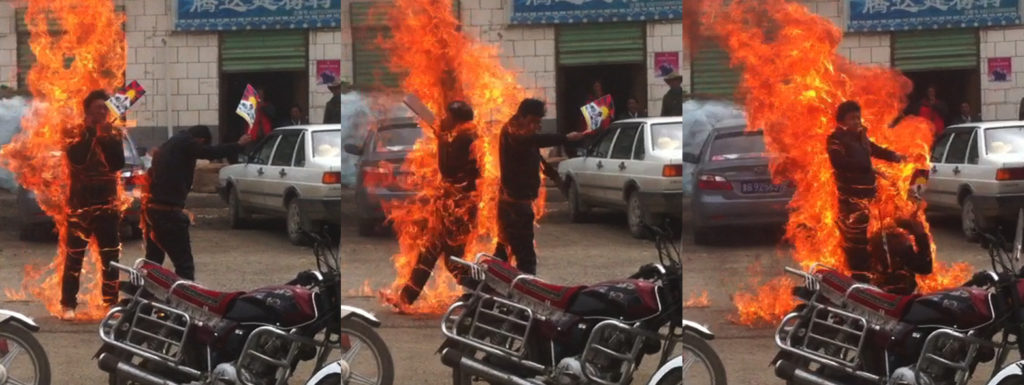Burning Against the Dying of the Light

The title of the installation reflects on Dylan Thomas’ poem, Do not go gentle into that good night, with its refrain “Rage, rage against the dying of the light.” While Dylan Thomas’ poem was an exhortation to his dying father not to die without a fight, this work examines the self-immolation protests in Tibet as part of a continuing struggle to prevent the light of an entire civilization from dying out.
A number of these fiery protests have been captured on mobile phones and secretly made available to the outside world. This act itself is punishable by long prison sentences. The hurriedly shot videos bring home in graphic and horrific detail, the physical reality of self-immolations. To witness a living human body engulfed in flames is a truly distressing and disturbing sight. But what right do we have to turn away our faces when the very point of such a public protest is to draw our attention to the cause they represent?
The Wheel of Light and Darkness
(mixed-media sculpture: metal, printed material and tablets)
This sculpture is in the form of a large rotating Buddhist prayer wheel. But unlike a typical Buddhist prayer wheel, it consists of its bare armature, ringed by metal bars. Rolls of religious text lie exposed at its heart. Embedded in a circle around its skeletal circumference is a number of tablets, each screen playing videos of the self-immolations as they were originally filmed. The prayer wheel is both a tribute to the courage of the activists and a grim reminder of the cause they died for – the slow disappearance of the very essence of their identity and culture. As in a traditional prayer wheel, each revolution of the wheel strikes a tiny bell, its sharp ring dispelling ignorance and sending out a message of hope and peace.
Funeral #1
(single-channel video, approximately 8 minutes)
This video follows the self-immolation and cremation of Ani Palden Choetso, a Buddhist nun who burnt herself on 13 November 2011 on a street corner in Tawu town in Eastern Tibet. Video footage subsequently smuggled out of Tibet shows her standing stock still, engulfed in flames, before collapsing. Later, a crowd gathers and prevents security officials from taking her body away. Her funeral is held at the local monastery where thousands chant prayers and hold a sombre candlelight vigil. Two days later, a hurriedly filmed mobile phone video shows the monastery under attack by armed forces. After this event, the authorities cracked down on performing funeral ceremonies for self-immolators.
Funeral #2
(single-channel video, approximately 8 minutes)
This video follows the self-immolation and cremation of Jamphel Yeshi who set himself alight during a peaceful demonstration in the heart of the Indian capital, New Delhi, on 26 March 2012. He died in hospital two days later. His death had the effect of galvanising the exile Tibetan community and elevating him to the status of a hero. The video starts with footage of Jamphel Yeshi in the crowd of demonstrators minutes before he set himself alight. It is followed by images of his self-immolation and footage of his funeral procession and cremation in Dharamshala, witnessed by hundreds of distraught Tibetans.
Two Friends
(single-channel video, approximately 10 minutes)
Two friends, Ngawang Norphel, 22, and Tenzin Khedup, 24, both former monks, took a vow to die together. On 20 June 2012, carrying the banned Tibetan national flag and shouting independence slogans, they set themselves on fire on a busy street in Trindu town in Eastern Tibet. Mobile phone footage captures their dramatic sacrifice. While Tenzin Khedup died on the spot, Ngawang Norphel was carried by monks to the local monastery. He died more than a month later in a Chinese hospital. While in the monastery, burnt beyond recognition, he talked on camera to the monks attending to him. This exchange – as he laments the situation in Tibet that led him to take this extreme action and asks after the welfare of his friend – poignantly conveys the urgency and desperation of how people in Tibet perceive their situation.
Nets in the Sky, Traps on the Ground
(mixed-media: video, printed material)
A series of Orwellian phrases taken from official Chinese documents that describe some of the many control mechanisms and restrictive measures aimed specifically at Tibetans will be projected on the walls and ceiling. Text from official documents outlining these policies will be displayed. These present a more comprehensive picture of the draconian laws that Tibetans live under, which don’t exist anywhere else in China. They will be complemented by before-and-after satellite images of rural areas transformed in line with the “New Socialist Villages” programme currently underway in Tibet that graphically demonstrate the extent of social engineering taking place in the region.
Last words
(mixed media: video, printed material)
Some of the final messages left behind by the self-immolators – both handwritten and as audio recordings – will be displayed and presented. These statements, sometimes matter-of-fact but often poetic and deeply philosophical, explain the reasons for deciding to burn themselves. In their mix of Buddhist compassion and political awareness, they provide a compelling insight into the unique nature of the Tibetan self-immolations.
Exhibitions:
Burning Against the Dying of the Light
Solo Exhibition
Khoj International Artist’ Association Studios, New Delhi
10–31 December, 2015
Polyphonic Worlds: Justice as Medium
Contour Biennale 8, Mechelen, Belgium
11 March–21 May, 2017
